| 1 | Master of grass camouflage |
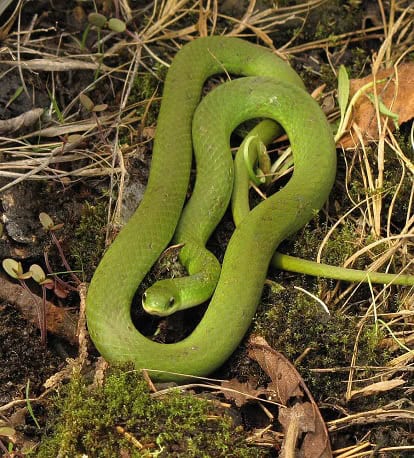
The smooth green snake (Opheodrys vernalis) is a small species inhabiting a wide stretch of the northeastern US. It measures 30-66cm, with a record of 79.7cm, and is completely harmless to humans. Despite being widespread, smooth green snakes aren’t spotted particularly commonly, and that’s because of their amazing leafy green camouflage.
The smooth green snake is almost a pure leafy green, with the exception of a creamy white belly. Immediately after birth, they begin as a grey-brown, before slowly morphing into olive or bluish-grey. The next stage is a significantly paler green, before they finally blossom into the fully green snake of adulthood.
As adults, smooth green snakes have barely any colour variety, with darker coloured individuals popping up just occasionally. This gives them almost unbeatable camouflage in long, swampy grasses, compared to other US snakes.
Smooth green snakes are found in numerous northeastern states, including Pennsylvania, Ohio, New York, Michigan and Maine, plus southeast Canada. They’re one of two members of the Opheodrys green snake genus, the other being the rough green snake (Opheodrys aestivus). This species lives much further south (Florida, Georgia, etc), and is slightly longer, with a record of 116cm. As the name suggests, they also have more jagged scales at their mid-section. The two species have a small area of overlap, particularly in Virginia and West Virginia.
| 2 | Turns blue after death |
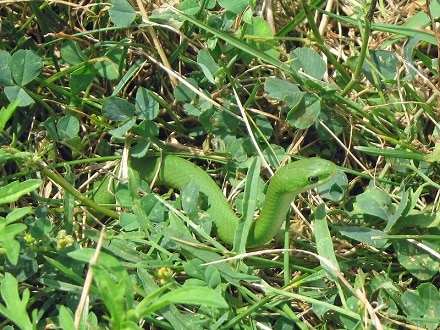
The goal of this species’ greenness is to camouflage itself, and at certain angles they can be practically invisible, even compared to the crafty grass snakes of Europe. In the last 10 seconds of this youtube video, the green scales and grass barely have a shade between them in colour. The smooth green snake would most likely register as a strange blip at the corner of your eye which vanishes before you have a chance to turn your head.
That being said, a little known fact is that this species isn’t green at all. The whole world is apparently a lie, as the smooth green snake (and the rough version) is actually covered with a blue-yellow pigment combo that gives the illusion of being green, with no green pigment existing.
This leads to an amazing phenomenon when the snake dies. Because the yellow pigments decompose significantly faster, smooth green snake corpses have a tendency to slowly turn blue. Scientists notice this phenomenon when they capture smooth green snakes for studying. The corpses are often stored in alcohol, and because the yellow pigment is alcohol soluble, it leaches into the solution and leaves the blue pigment to predominate.
| 3 | Divided into pockets |
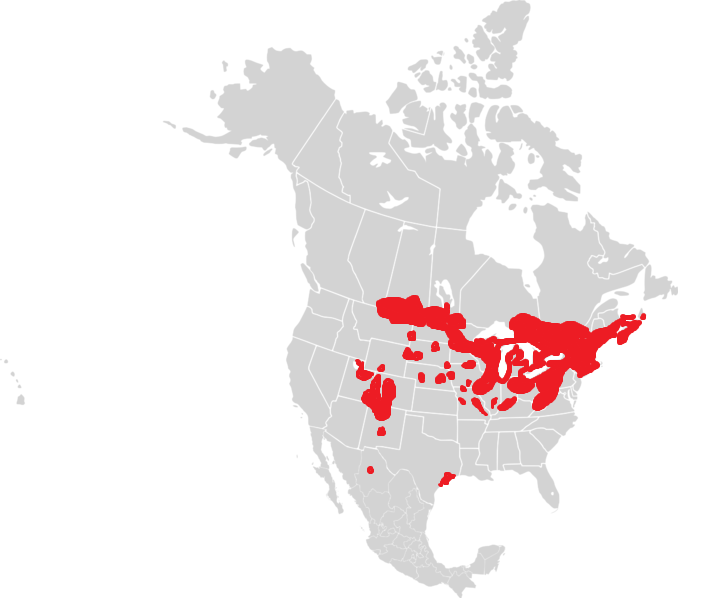
The interesting thing about the smooth green snake is how its empire is now fragmented and divided. With the corn snake species (popular as pets), there’s a consistent swathe across the eastern US from Florida to southern New Jersey. The smooth green snake is generally a creature of the north-east US, plus south-east Canada, including Prince Edward Island. Across that region, it exists in a complete, unbroken empire. But in the mid-west and south-west of America, there are many isolated pockets of smooth green snakes, 24 of them to be exact, which are completely adrift from the main range.
It’s believed that these pockets are isolated relics which became stranded as the climate warmed up after the last ice age. For example, scientists have unearthed fossils of the smooth green snake in Florida, where it’s nowhere to be found today. There’s even a surviving pocket in northern Mexico, in Chihuahua province.
In 1925, biologists found a colony at the altitude of 8000 feet in southern Colorado, and the Sierra Madre Range of Wyoming is another place where they stubbornly cling on. Scientists believe that the western pockets and large eastern range were separated around 8000-13000 years ago.
| 4 | Roams grass and swamp |
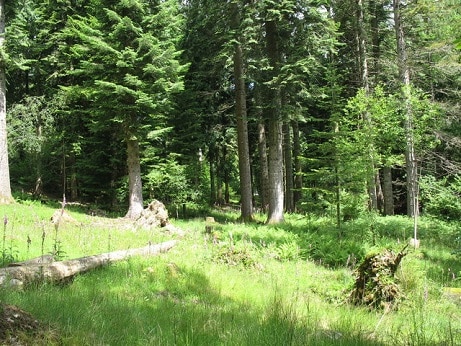
Smooth green snakes don’t just favour grassy areas. They particularly love moist, rich herbaceous grasses which are full to the brim with shrubs. Some of the true hotspots for this species are rich grassy areas on the outskirts of forests, or the grassy clearings within forests. They’re also found within abandoned buildings, overgrown farm fields or even in people’s gardens in more rural areas.
The rule is that the richer the vegetation, the better for this species, and this is probably connected to their insect-heavy diet. The edges of marshes and swamps are another place where they congregate, although never inside the swamps themselves. Unlike corn snakes, this species is incapable of slithering up trees.
The smooth green snake has several reserve hidey holes when hibernation season comes around. Like many snakes, they take shelter in mammal burrows, but another favourite is old abandoned anthills. Rock crevices are another favourite, as are rotting logs, or spaces in gravel.
Within their ranges, they’re far less common than their rival the rough green snake, with an average population density of 74 per hectare versus approximately 295 per hectare. This is almost certainly because the rough version lives in warmer, cosier climates.
| 5 | A spider-eating snake |
The smooth green snake has exceptional camouflage, but its other snake abilities are lacking somewhat. There are no venom glands connected to its sharp fangs, it doesn’t constrict its prey with its green body, and its night vision is hardly anything special. It’s also a fairly small snake. That’s why instead of mice and birds, the smooth green snake hoovers up vast amounts of insects for its sustenance.
Creepy crawlies on its menu include ants, worms, slugs, moth larva, grasshoppers and spiders. It’s said that smooth green snakes are a farmer’s best friend (and a pesticide company’s enemy), as they steadily devour the pests which ruin their crops.
Like corn snakes with their unending mice obsession, smooth green snakes have certain meals which can’t get enough of. Back in 1939, scientists studied smooth green snakes in the wilds of Virginia. They found that on average, their stomach contents consisted of 37% caterpillar, 32% spiders, 20% grasshoppers, 10% ants, and 1% snails and slugs. But the studies don’t fully agree, as a 1960 survey by Dr Judd found that the species’ favourites were spiders and flies. They’ve also been observed eating crayfish. It almost certainly depends on their local areas, but spiders are one name that appears repeatedly.
| 6 | Increasingly endangered |
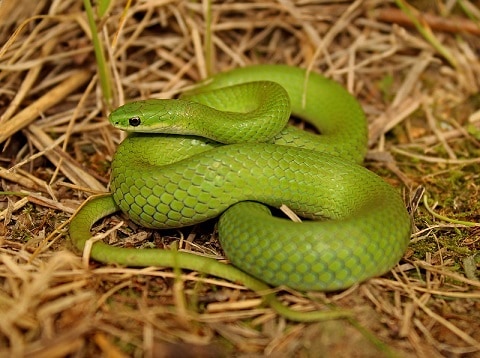
Unfortunately, this fondness for insects may be the species’ undoing. The smooth green snake is ranked as least concern by ICUN. There’s no proof that they’re declining, but increasing amounts of anecdotal reports are appearing which hint that they’re declining in certain regions. For example, the species was once widespread in Iowa, but as of 2006, it was reduced to 10 small locations. They’re said to be increasingly rare in New York state.
Insecticides are widely believed to be the problem. When blasted on crops, the chemicals are absorbed into the insects’ bodies, which are then passed into the snake’s bodies, in a distorted circle of life. The fact that they sometimes hang out in agricultural fields adds to their vulnerability.
Smooth green snakes are now a protected species in Wyoming, Nebraska, and Colorado, and the law forbids people from taking them captive, both for personal reasons or commercial reasons.
Many reptile enthusiasts have scooped them out of the grass and taken them home in the past, but despite being a docile and timid snake, smooth green snakes fare very poorly in captivity. They commonly refuse to eat, even if offered worms or spiders.
| 7 | Killed by speeding traffic |
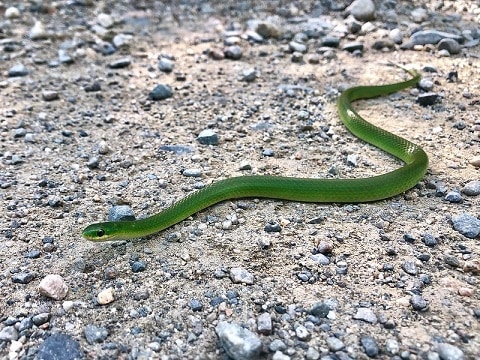
Another threat to the smooth green snake is pollution, such as gasoline or oil spilling into local swamps. Campers and enthusiasts are thought to be leaving rubbish near their habitats, which attracts racoons, and possibly other animals who gobble up the local smooth green snakes as a side dish.
Then there’s the old enemy: roadside deaths. A Pittsburgh journalist noticed a dead smooth green snake on a gravel road in this report from 2009, which was already turning blue as its yellow pigment dissolved. There was a clear tyre mark on its back. Even the weather is a problem, as it’s believed that smooth green snakes are particularly vulnerable to sudden freezes or flooding.
Some scientists believe that the smooth green snake may be more common in the west than previously thought. The US is vast, and many of the foothills of the Rocky mountains have barely been surveyed. But another option is that the western pockets are merely clinging on, as they have done since the last ice age, and that every natural disaster is another accelerator on the road to their eventual disappearance, regardless of humanity’s presence. It’s possible that in 500 years, the last remaining western snakes will depart for the eastern heartlands similarly to the elves in Lord of the Rings.
| 8 | The search in eastern Canada |
Despite the doom and gloom, there are several locations where the smooth green snake is silently maintaining a stronghold. One is Prince Edward Island, off the eastern coast of Canada. This island was long stated to have three snake species, with the other two being the garter snake and northern redbelly. In 2016, biologists were growing concerned, as they hadn’t recorded an official sighting of Opheodrys vernalis for 15 years. With only so much budget to be spread around, their scientists couldn’t comb the entire island with a magnifying glass. Instead, they sent out a plea to the public, asking them to report sightings with the P.E.I. Nature Tracker app.
After a large splash in the media, the search for the snake went quiet for a while. There was no official announcement, but in a 2019 article discussing a garter snake that a 7 year old boy had found in the toilet, they casually mentioned how several reliable sightings of the smooth green snake had been sent in. “We did successfully get a few observations of that species so we know they’re still here” said Garry Gregory. Although some may not be happy to hear it, Prince Edward Island is officially more snake-infested than previously believed.
| 9 | Communal hibernation |
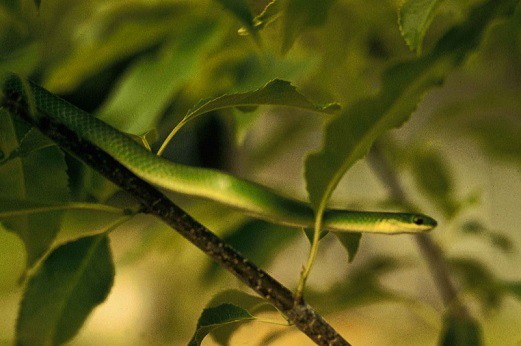
Like the garter snake or Louisiana pinesnake, the smooth green snake is diurnal, an animal most active during the daytime. A 1947 study found that their favourite temperatures to go on the prowl (or slither) are 70-85F. They like to warm themselves by basking on roads, which is one reason why death by roadkill is such a danger.
One special feature of this species is that they often hibernate together, in communal formation. In fact, this is one reason why they’re vulnerable – if one denning site is destroyed, then the entire neighbourhood is finished. This is an egg-laying species, like 70% of snakes. They don’t lay many eggs, just 3-13 at once, far less than the puff adder at 20-40 or even the corn snake at 10-30. The species will sometimes lay its eggs together as well.
This is far from an invincible species, as its predators are numerous, including American hawks, crows, racoons, foxes, and possibly bigger, badder snakes like the king snake. Back in 1948, a biologist observed a smooth green snake being bitten by a black widow spider and later succumbing to the poison. That said, they always put up a fight, thrashing around and spraying their enemies with a foul smelling fluid.
| 10 | Moves just 10 metres daily |
Scientists have tried desperately to discover more about this species’ lifestyle. From 1986 to 1988, they captured 64 smooth green snakes from the Rocky mountains. Their goal was to monitor their daily movements, but the technology was so primitive that they couldn’t find trackers small enough to physically implant.
Nevertheless, all signs suggest that they’re a relatively lazy species, moving just 10 metres per day on average. Over in the Arizona desert, the sidewinder rattlesnake moves 100 metres per day on average. This is why as a species, the smooth green snake can be localised to an extreme level. They can be plentiful in one swampy forest clearing, but completely non-existent in the surrounding fields.
What happens if you’re in a forest, your map reading skills fail, and you suddenly find yourself in the smooth green snake-infested forest clearing from hell? Not much, as this species almost never bites humans. They usually remain completely still, and if you pick them up, they normally get overexcited for a second before wrapping themselves around your finger. They’re not trying to constrict you, merely to cling on, and gangs of smooth green snakes will never team up to take down prey 100 times larger than they are (that we know of).
